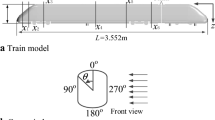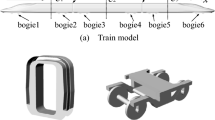Abstract
Calculation grid and turbulence model for numerical simulating pressure fluctuations in a high-speed train tunnel are studied through the comparison analysis of numerical simulation and moving model test. Compared the waveforms and peak-peak values of pressure fluctuations between numerical simulation and moving model test, the structured grid and the SST k-ω turbulence model are selected for numerical simulating the process of high-speed train passing through the tunnel. The largest value of pressure wave amplitudes of numerical simulation and moving model test meet each other. And the locations of the largest value of the initial compression and expansion wave amplitude of numerical simulation are in agreement with that of moving model test. The calculated pressure at the measurement point fully conforms to the propagation law of compression and expansion waves in the tunnel.
摘要
通过动模试验和数值模拟的对比分析,研究了不同计算网格和湍流模型模拟高速列车通过隧道 时引起的压力瞬态。对比数值模拟和动模型试验得到的压力波动波形和最大峰峰值,选用了SST k-ω 湍流模型和结构化网格数值模拟高速列车通过隧道的过程。数值模拟与动模试验的最大压力波振幅值 相吻合。数值模拟的初始压缩波和膨胀波振幅最大的位置与动模试验的位置一致。测点的计算压力完 全符合隧道中压缩波和膨胀波的传播规律。
Similar content being viewed by others
References
TIAN Hong-qi. Train aerodynamics [M]. Beijing: China Railway Publish House, 2007. (in Chinese)
WANG Tian-tian, JIANG Chong-wen, GAO Zhen-xun, LEE Chun-hian. Numerical simulation of sand load applied on high-speed train in sand environment [J]. Journal of Central South University, 2017, 24: 442–447. DOI: 10.1007/s11771-017-3446-4.
TAO Yu, YANG Ming-zhi, QIAN Bo-sen, WU Fan, WANG Tian-tian. Numerical and experimental study on ventilation panel models in a subway passenger compartment [J]. Engineering, 2019, 5: 329–336. DOI: 10.1016/j.eng.2018. 12.007.
ZHOU Dan, TIAN Hong-qi, ZHANG Jian, YANG Ming-zhi. Pressure fluctuations induced by a high-speed train passing through a station [J]. Journal of Wind Engineering and Industrial Aerodynamics, 2014, 135: 1–9. DOI: 10.1016/j.jweia.2014.09.006.
KIM J Y, KIM K Y. Experimental and numerical analyses of train-induced unsteady tunnel flow in subway [J]. Tunnelling and Underground Space Technology, 2007, 22: 166–172. DOI: 10.1016/j.tust.2006.06.001.
SOPER D, BAKER C J, STERLING M. Experimental investigation of the slipstream development around a container freight train using a moving model facility [J]. Journal of Wind Engineering and Industrial Aerodynamics, 2014, 135: 105–117. DOI: 10.1016/j.jweia.2014.10.001.
BELLENOUE M, MORINIERE V, KAGEYAMA T. Experimental 3-D simulation of the compression wave, due to train-tunnel entry [J]. Journal of Fluids and Structures, 2002, 16: 581–595. DOI: 10.1006/jfls.2002.044.
RICCOA P, BARONB A, MOLTENI P. Nature of pressure waves induced by a high-speed train travelling through a tunnel [J]. Journal of Wind Engineering and Industrial Aerodynamics, 2007, 95: 781–808. DOI: 10.1016/j.jweia. 2007.01.008.
ZHANG Lei, YANG Ming-zhi, LIANG Xi-feng, ZHANG Jian. Oblique tunnel portal effects on train and tunnel aerodynamics based on moving model tests [J]. Journal of Wind Engineering and Industrial Aerodynamics, 2017, 167: 128–139. DOI: 10.1016/j.jweia.2017.04.018.
ENDO H, MEGURO F, OTA M. Small model experiment on the gradient of pressure wave by entering the tunnel of a conventional limited express [J]. Proceedings of the Japan Society for Photoelasticity, 2014, 14: 42–47. DOI: 10.11395/ jjsem.14.s42.
ZHOU Dan. Research on the long tunnel and tunnel group’s aerodynamic algorithm and its application [D]. Changsha: Central South University, 2007. (in Chinese)
OGAWA T, FUJII K. Numerical investigation of three-dimensional compressible flows induced by a train moving into a tunnel [J]. Computers and Fluids, 1997, 26: 565–585. DOI: 10.1016/S0045-7930(97)00008-X.
WANG Tian-tian, LEE Chun-xian, YANG Ming-zhi. Influence of enlarged section parameters on pressure fluctuations in a high-speed train tunnel [J]. Journal of Central South University, 2018, 25: 2831–2840. DOI: 10.1007/s11771-018-3956-8.
WANG Tian-tian, WU Fan, YANG Ming-zhi, JI Peng, QIAN Bo-sen. Reduction of pressure fluctuations in a high-speed train tunnel by cross-section increase [J]. Journal of Wind Engineering and Industrial Aerodynamics, 2018, 183: 235–242. DOI: 10.1016/j.jweia.2018.11.001.
ZHANG Lei, HUROW K, STOLL N, LIU Hui. Influence of the geometry of equal-transect oblique tunnel portal on compression wave and micro-pressure wave generated by high-speed trains entering tunnels [J]. Journal of Wind Engineering and Industrial Aerodynamics, 2018, 178: 1–17. DOI: 10.1016/j.jweia.2018.05.003.
HEMIDA H, GIL N, BAKER C J. LES of the slipstream of a rotating train [J]. Journal of Fluids Engineering, 2010, 132: 1031–1039. DOI: 10.1115/1.4001447.
CHEN Jing-wen, GAO Guang-jun, ZHU Chun-li. Detached-eddy simulation of flow around high-speed train on a bridge under cross winds [J]. Journal of Central South University, 2016, 23: 2735–2746. DOI: 10.1007/s11771-016-3335-2.
MALEKI S, BURTON D, THOMPSON M C. Assessment of various turbulence models (ELES, SAS, URANS and RANS) for predicting the aerodynamics of freight train container wagons [J]. Journal of Wind Engineering and Industrial Aerodynamics, 2017, 170: 68–80. DOI: 10.1016/j.jweia. 2017.07.008.
MORDEN J A, HEMIDA H, BAKER C J. Comparison of RANS and detached eddy simulation results to wind-tunnel data for the surface pressures upon a class 43 high-speed train [J]. Journal of Fluids Engineering, 2015, 137: 1–9. DOI: 10.1115/1.40292.
Author information
Authors and Affiliations
Corresponding author
Rights and permissions
About this article
Cite this article
Ji, P., Wang, Tt. & Wu, F. Calculation grid and turbulence model for numerical simulating pressure fluctuations in high-speed train tunnel. J. Cent. South Univ. 26, 2870–2877 (2019). https://doi.org/10.1007/s11771-019-4220-6
Received:
Accepted:
Published:
Issue Date:
DOI: https://doi.org/10.1007/s11771-019-4220-6




